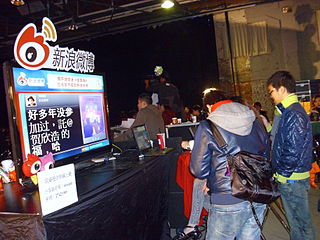Related Research Articles
Answers.com, formerly known as WikiAnswers, is an Internet-based knowledge exchange. The Answers.com domain name was purchased by entrepreneurs Bill Gross and Henrik Jones at idealab in 1996. The domain name was acquired by NetShepard and subsequently sold to GuruNet and then AFCV Holdings. The website is now the primary product of the Answers Corporation. It has tens of millions of user-generated questions and answers, and provides a website where registered users can interact with one another.

User-generated content (UGC), alternatively known as user-created content (UCC), is generally any form of content, such as images, videos, audio, text, testimonials, and software, that has been posted by users on online content aggregation platforms such as social media, discussion forums and wikis. It is a product consumers create to disseminate information about online products or the firms that market them.

Livestreaming, live-streaming, or live streaming is the streaming of video or audio in real time or near real time. While often referred to simply as streaming, the real time nature of livestreaming differentiates it from other forms of streamed media, such as video-on-demand, vlogs, and YouTube videos.

Infillion, formerly known as Gimbal | true[X], TrueX, Inc. and SocialVibe, is an American digital advertising company founded in 2007 by Joe Marchese, Brandon Mills and David Levy. The company is headquartered in Los Angeles and New York City. It was previously owned by 21st Century Fox, from 2014 until Disney's acquisition of 21st Century Fox in 2019, and The Walt Disney Company from 2019 until 2020.

Social media marketing is the use of social media platforms and websites to promote a product or service. Although the terms e-marketing and digital marketing are still dominant in academia, social media marketing is becoming more popular for both practitioners and researchers.
NyooTV is a video on demand platform built using adaptive streaming and customized mobile applications which is claimed to work even with low bandwidths. It aggregates and offers Indian entertainment content across new media platforms and digital entertainment devices currently to Indian audiences in US and India. Registered users can get news about movies by following NyooTV through social networking sites. NyooTV provides global video content like TV shows, Bollywood films, Bollywood news, New Bollywood songs, events and sports events of interest to Indian consumers.

Hootsuite is a social media management platform, created by Ryan Holmes in 2008. The system's user interface takes the form of a dashboard, and supports social network integrations for Twitter, Facebook, Instagram, LinkedIn, Pinterest, YouTube and TikTok.
Klout was a website and mobile app that used social media analytics to rate its users according to online social influence via the "Klout Score", which was a numerical value between 1 and 100. In determining the user score, Klout measured the size of a user's social media network and correlated the content created to measure how other users interact with that content. Klout launched in 2008.

Instagram is a photo and video sharing social networking service owned by Meta Platforms. It allows users to upload media that can be edited with filters, be organized by hashtags, and be associated with a location via geographical tagging. Posts can be shared publicly or with preapproved followers. Users can browse other users' content by tags and locations, view trending content, like photos, and follow other users to add their content to a personal feed. A Meta-operated image-centric social media platform, it is available on iOS, Android, Windows 10, and the web. Users can take photos and edit them using built-in filters and other tools, then share them on other social media platforms like Facebook. It supports 32 languages including English, Spanish, French, Korean, and Japanese.
GyPSii is a provider of geosocial networking applications and services for the iPhone, iPod, iPad, BlackBerry OS, Android and Java-based phones, Symbian S60 and S40, Windows Mobile and MID notebooks. The company is headquartered in Amsterdam, Netherlands, with offices in Asia and the United States.

Social media and television have a number of connections and interrelationships that have led to the phenomenon of Social Television, which is an emerging communication digital technology that centers around real-time interactivity involving digital media displayed on television. The main idea behind Social Television is to make television consumption a more active content experience for audiences. In the 2010s, social media platforms and websites allowed for television shows to be accessed online on a range of desktop and mobile computer devices, smartphones and smart TVs that are still evolving today in the 2020s. Alongside this, online users can use social media websites to share digital video clips or excerpts from TV shows with fellow fans or even share an entire show online. Many social media websites enable users to post online comments on the programs—both negative and positive—in a variety of ways. Viewers can actively participate while watching a TV program by posting comments online, and have their interactions viewed and responded to in real time by other viewers. Technologies such as smartphones, tablets, and laptop computers allow viewers to watch downloaded digital files of TV shows or "stream" digital files of TV shows on a range of devices, both in the home and while on the go. In the 2020s, many television producers and broadcasters encourage active social media participation by viewers by posting "hashtags" on the TV screen during shows. These hashtags enable viewers to post online comments about the show, which may either be read by other social media users, or even, in some cases, displayed on the screen during the show.
140 Proof is an advertising company that uses social data from many sources in targeting relevant ads based on consumers' interests as indicated by their social activity across networks.

Viralheat was a subscription-based software service for social media management that helps clients monitor and analyze consumer-created content. It was first released in beta in May 2009. Viralheat raised $75,000 in seed capital in December 2009 and $4.25 million of venture capital from the Mayfield Fund in 2011.
The history of Twitter, later known as X, can be traced back to a brainstorming session at Odeo.

Grabyo is a browser-based live video production suite integrated with other social media platforms such as Facebook, YouTube, Instagram, Snapchat, Twitter, and Periscope. Sports federations and media companies use cloud-based technology to produce professional-quality live streams and video clips for digital audiences.
Twitter Amplify is a video advertising product that Twitter launched for media companies and consumer brands in May 2013. The product gives broadcasters the opportunity to publish real-time in-tweet video clips that are accompanied by pre-roll or post-roll advertisements. It is Twitter's major initiative in social television, designed to enhance the user experience with premium and timely TV highlights, enable broadcasters to reach new audiences and provide brands with a cross-platform tool for reaching the social conversation around major events.
90min is a technology-enabled football news platform, which produces Internet content covering various football leagues. The content offered by the platform is user-generated following the principles of citizen journalism. The first London based company website was launched in 2011 as FTBpro.com by Israeli entrepreneurs Yuval Larom, Asaf Peled, and Gilad Beiman, a group which operates today as Minute Media.
Innovid is an American online advertising technology company that offers services used by advertisers and publishers for the distribution and management of digital ads. Originally launched as a video marketing platform, the company expanded its offering to include display and digital out-of-home when Herolens was acquired in 2019.

ShareChat is an Indian social networking service platform, owned by Bangalore-based Mohalla Tech. It was founded by Ankush Sachdeva, Bhanu Pratap Singh and Farid Ahsan, and incorporated on 8 January 2015. ShareChat app has over 350 million monthly active users across 15 Indian languages. The current valuation of the company is $5 billion.
References
- ↑ Dumenco, Simon (April 13, 2012). "Believe The Hype? Four Things Social TV Can Actually Do". Ad Age. Retrieved May 24, 2014.
- ↑ "Watchlist Predicts Fall TV Show Success". Mashable .
- ↑ Lomas, Natasha (October 12, 2012). "Report: Social TV Market To Be Worth $256.44BN By 2017; Europe Taking Largest Share Now". TechCrunch. Retrieved May 24, 2014.
- ↑ "MIT Technology Review on Social TV".
- ↑ "David Rowan, the Editor of Wired magazine". Wired UK. 2011-01-11.
- ↑ "Ynon Kreiz, CEO of the Endemol Group told a packed crowd". Archived from the original on 2011-01-30.
- ↑ Roettgers, Janko (January 29, 2014). "Let's face it: social TV is dead". Gigaom. Archived from the original on February 16, 2023. Retrieved May 24, 2014.
- ↑ Roettgers, Janko (April 14, 2014). "Amid social TV consolidation, Zeebox rebrands as Beamly". Gigaom. Archived from the original on February 16, 2023. Retrieved May 24, 2014.
- ↑ Constine, Josh (May 21, 2014). "Facebook Adds Shazam-Style Audio Recognition To Help You Automatically Tag Posts With TV Shows And Songs". TechCrunch. Retrieved May 26, 2014.
- ↑ Indvik, Lauren (May 23, 2013). "Twitter Amplify Will Bring Sponsored Video Clips to Your Feed". Mashable. Retrieved May 25, 2014.
- ↑ Lunden, Ingrid (May 23, 2013). "Twitter Launches TV Ad Targeting, Twitter Amplify For Real-Time Videos In Stream". TechCrunch. Retrieved May 25, 2014.
- ↑ Wasserman, Todd (February 27, 2014). "Twitter Snags the Last of the Major Networks, ABC, for Amplify". Mashable. Retrieved May 25, 2014.
- ↑ Sawers, Paul (June 19, 2014). "Twitter's evolution as a broadcasting platform continues as it acquires live-TV clipping service SnappyTV". The Next Web. Retrieved August 28, 2014.
- ↑ Sawyers, Paul (June 10, 2014). "Wimbledon 'near-live' highlights will be broadcast globally across Facebook, Twitter, Google+ and YouTube". TNW. Retrieved June 12, 2014.
- ↑ Ashford, Holly (March 26, 2015). "Facebook partners with London-based start-up Grabyo". TVBEurope. Archived from the original on June 11, 2016. Retrieved July 26, 2015.
- ↑ Wagner, Kurt (July 1, 2015). "YouTube Beware: Facebook Will Start Sharing Ad Revenue With Video Creators". Recode. Retrieved July 27, 2015.
- ↑ Perez, Sarah (2018-03-12). "TV Time, the TV tracking app with over a million daily users, can now find your next binge – TechCrunch". TechCrunch. Archived from the original on 2023-02-16. Retrieved 2021-06-18.
- ↑ Smith, Cooper (September 30, 2013). "How Social Media Is Being Used To Amplify TV Advertising". Business Insider. Retrieved 2016-12-18.
- ↑ Indvik, Lauren (July 31, 2013). "Facebook Study: We're Bigger Than Prime-Time TV". Mashable. Retrieved May 25, 2014.
- ↑ Nielsen Social (October 7, 2013). "Facebook Study: We're Bigger Than Prime-Time TV". Nielsen Social. Archived from the original on August 4, 2019. Retrieved May 25, 2014.
- ↑ Gross, Doug (February 3, 2014). "Super Bowl sets Twitter records" . Retrieved May 26, 2014.
- ↑ Abbruzzese, Jason (February 3, 2014). "50 Million People Discussed the Super Bowl on Facebook" . Retrieved May 26, 2014.
- ↑ Dredge, Stuart (April 9, 2014). "Twitter stakes its claim as TV's 'synchronised social soundtrack'" . Retrieved May 26, 2014.
- ↑ Flomenbaum, Adam (July 17, 2015). "Wimbledon generates over 48 million video views across social platforms" . Retrieved July 27, 2014.
- ↑ Archived April 23, 2011, at the Wayback Machine
- ↑ Halperin, Shirley (June 20, 2011). "How 'The Voice' Uses Twitter to Raise Ratings". The Hollywood Reporter. Retrieved November 19, 2019.
- ↑ 9/20/11. http://tvrecaps.ew.com/viewer/episode/?id=EP011413890047
- ↑ William M. Bulkeley. "TR10: Social TV". MIT Technology Review. Archived from the original on 24 March 2022. Retrieved 24 February 2016.
- ↑ ReeD Martin; Ana Luisa Santos; Mike Shafran; Henry Holtzman & Marie Jose Montpetit (2010). neXtream: A Multi-Device, Social Approach to Video Content Consumption (PDF). 2010 IEEE Consumer Communications and Networking Conference. pp. 779–783. Retrieved 2011-10-01.
- ↑ Social Interactive Television: Immersive Shared Experiences and Perspectives. IGI Global. 2009. ISBN 9781605666563 . Retrieved 2 October 2015.
- ↑ "Partnerships, emerging trends, breaking news in the media and communications industry". mrgco.com. Archived from the original on 16 February 2023. Retrieved 2 October 2015.
- ↑ Kyriazis D.; et al. (2011), "Interactive Social TV on Service Oriented Environments: Challenges and Enablers", 2011 Third International Conference on Games and Virtual Worlds for Serious Applications, Third International Conference on Games and Virtual Worlds for Serious Applications (VS-GAMES), IEEE, pp. 152–155, CiteSeerX 10.1.1.689.4201 , doi:10.1109/VS-GAMES.2011.30, ISBN 978-1-4577-0316-4, S2CID 6049434